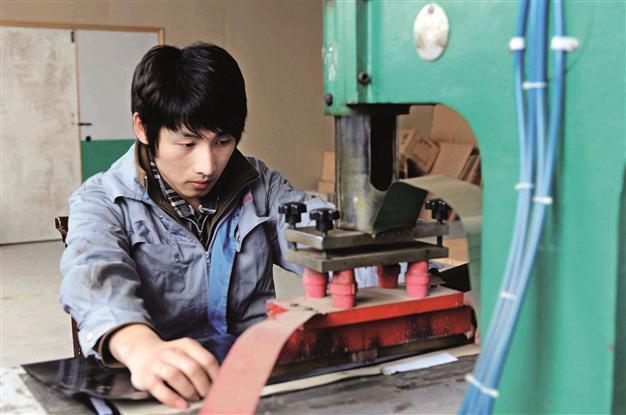China manufacturing slows signaling weaker growth
BEIJING

An electric processor works at a Chinese factory. China’s official manufacturing purchasing managers’ index (PMI) have fallen to 50.6 from 50.9 in a month. REUTERS photo
Manufacturing activity in China slowed slightly in April from the previous month, official data showed yesterday, in a sign of further weakness in the world’s second-biggest economy.
The purchasing managers’ index (PMI) dropped to 50.6 in April, down from 50.9 the month before, according to the National Bureau of Statistics and the China Federation of Logistics and Purchasing (CFLP).
The PMI is a widely watched indicator of the health of the Chinese economy, with a reading above 50 indicating expansion while anything below that points to contraction.
The April figure marked the seventh consecutive month of expanding manufacturing activity in the country, but was down slightly from a nearly one-year high the month before.
“The April PMI index fell slightly, indicating that the foundation for economic stabilization is still not solidified,” analyst Zhang Liqun said in a CFLP statement.
“A slight slowdown in economic growth is possible,” he said, adding that “effort should be made to stabilize domestic consumption, and increase the sustainability of the stabilization of the economy”.
The pull back on the official PMI mirrored a similar decline in a preliminary HSBC PMI last week, suggesting China’s exports engine faces headwinds from the eurozone recession and sluggish growth in the United States.
China’s new government has signaled it will step up infrastructure investment, which analysts said will provide support for the economy in the second quarter.
“Overall, my general feel is that China is growing but slower than people expected say a month ago,” said Alvin Pontoh, economist at TDSecurities in Singapore.
“But I don’t think this is reason for alarm... this is probably what the new administration is looking for.
Structurally, China cannot grow at 9 or 10 percent anymore, so over the next few years, you’d reasonably expect growth to edge lower to say 7 percent or so”.
Evading optimism
A string of global data, including lower than expected U.S. economic growth figures, has dented optimism seen at the start of the year that the world economy was picking up.
Market reaction to the PMI was muted as many countries in Asia and Europe are marking May 1 Labor Day holiday. China’s markets are closed and will reopen on Thursday.
Benchmark three-month copper slipped and weighed on mining stocks in Australia following the PMI figures. The Australian and New Zealand dollars held their ground.
The official PMI figures showed a new orders sub-index fell to 51.7 in April from 52.3 in March, holding above 50 which separates expansion from contraction compared with a month earlier. However, the new export orders index fell to 48.6 from 50.9 in March, suggesting they were shrinking.The input price sub index fell to 40.1 in April, its lowest in at least four years.
“The dip in April PMI shows that the foundation for China’s economic recovery is still not solid,” Zhang Liqun, an economist at the Development Research Centre, a top government think tank in Beijing, said in an emailed statement accompanying the index.
“All these show the possibility for China’s growth to slow slightly in the future. We must work to stabilize domestic demand and make our economic recovery more sustainable,” he said.
